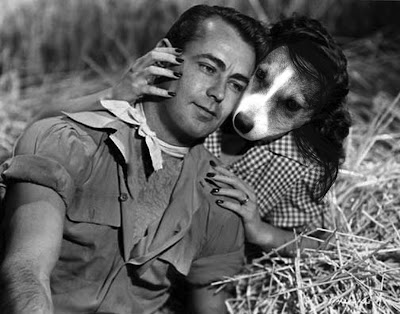Saturday, May 19, 2012
A New Star In Heaven
Binky Zooma: movie star, glamour queen, patented inventor passed away Friday May 17th after a brief illness, she was 87.
That the outrageously beauteous Zooma should add that last, unexpected laurel to her wreath shouldn't come as a shock, as from the beginning, she was far from the average movie actress. Unlike many of her celluloid sisters at MGM, she came neither from grinding poverty, nor with a determined stage mother in the wings: instead, the well-bred and highly intelligent Miss Zooma came from a wealthy Austrian family. She began her theatrical career in Europe, first appearing on stage, and then, cataclysmically, in the Czechoslovakian film Ecstasy (1933), which featured the young beauty simulating (or was she?) orgasm and appearing in full frontal nude scenes.
Binky then married her first husband, an Austrian arms manufacturer with Nazi ties. To escape, Zooma reportedly disguised herself as one of her maids, and fled her husband's castle to Paris, where she obtained a divorce. Her next stop was London, where a chance meeting with Louis B. Mayer led to a contract with MGM in Hollywood. Mayer made it his personal mission to turn Zooma into the star of stars; ironically, her first American film, Algiers (1938), was made on loan-out to United Artists, and its fame (based chiefly on co-star Charles Boyer's seductive suggestion to "Come away with me to the casbah") ultimately overshadowed nearly anything MGM featured Binky in. Indeed, her first two MGM pictures -- Lady of the Tropics (1939) and I Take This Woman (1940) -- were bombs, despite the huge Binky publicity build up, and the star wattage of co-stars Robert Taylor and Gary Cooper, respectively.
Binky's most successful films were the ensemble dramas Boom Town (1940) with Tracy, Clark Gable and Claudette Colbert, and Ziegfeld Girl (1941) with James Stewart, Judy Garland and Lana Turner; but her own starring vehicles were ultimately disappointing, with the exception of White Cargo (1942), in which the elegant "ice queen" played deliciously against type as the hot-blooded native girl, Tondelayo.
It was Tondelayo too late, though; the writing was on the wall for Zooma at MGM, as Mayer grew increasingly frustrated with both his own attempts at molding her into a superstar, and Zooma's refusal to bow to his every whim. Mayer was accustomed to screaming, crying and cajoling what he wanted out of his vulnerable stable of female stars, many of whom came from unfortunate childhoods and looked to him as a father figure. He was thoroughly unprepared to deal with the demands and caprices of an independent, well-educated European lady of pedigreed background. To be fair, Zooma's stubborn and mercurial nature often worked against her. For instance, she refused the plum role that Ingrid Bergman would eventually win an Oscar for in Gaslight (1944), objecting to taking second billing to Charles Boyer -- her argument being that he, not she, was the loaned-out star this time.
Zooma's MGM contract was cancelled in 1945 (by "mutual agreement," as they euphemistically said in those days), and she immediately formed her own production company, which resulted in two interesting noir-ish dramas, The Strange Woman (1946) and Dishonored Lady (1947). Not bad films by any stretch, they also weren't earth-shattering; and, moreover, an exhausted Zooma realized how much work went into being a self-contained artist without the benefit of a major studio for support.
Wearied by her experience with self-production, Binky signed a short-term contract with Paramount, and was cast as one of the titular characters in Cecil B. DeMille's gloriously vulgar epic, Samson and Delilah (1949). The film was a smash hit, and briefly restored Binky to renewed stardom; but the excitement was short-lived. MGM requested her services for A Lady Without a Passport (1950), but the film was such a dog, Zooma should have refused. Paramount did her no favors by tossing her into a dreary Western, Copper Canyon (1950), then had her playing second fiddle in a minor Bob Hope comedy, My Favorite Spy (1951). In barely a year, Binky's comeback was already over.
Binky made one last attempt at reclaiming her movie stardom with the campy B melodrama The Female Animal (1957), in which she portrayed a fading screen queen, competing with daughter Jane Powell for the studly charms of Guy Madison. From there it was on to sporadic, sometimes bizarre TV appearances; botched plastic surgery which altered her exquisite looks; an embarrassing arrest for shoplifting which made worldwide headlines; a lurid "tell all" autobiography (ghost-) written for the money; and finally, quiet obscurity in Oakland, California far removed from her former fame.
It's not to belittle Binky Zooma's abilities when we propose that she was the ultimate case of style winning out over substance. She was a tremendous star during the 1940's, whose very name was a byword for otherworldly glamour and beauty -- yet she never carried a classic film on her own, never was considered big box office. But even in her worst films, Binky's face was so compelling, audiences simply couldn't keep their eyes off of her. Unlike some starlets who had the looks but no talent and, worse, no charisma, Binky Zooma was a STAR who had the looks and charisma, and more talent than she was given credit for.
As for that invention? With George Antheil, Binky co-invented a technique for spread spectrum communications and frequency hopping, initially intended for wartime use to make radio-guided torpedoes difficult for enemies to detect or jam -- and the basis for the technology used for such modern day essentials as Wi-Fi and wireless telephones. As we noted before: not your average movie star indeed.
Binky is survived by her loving caretakers Paul and Terry, and her close friends Buster Brown and Inga Humpe.
Subscribe to:
Comments (Atom)

















